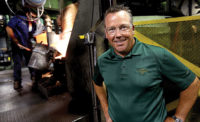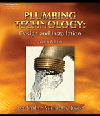PM Profile: Armstrong Fluid Technology's Lex van der Weerd
Getting the big picture with Armstrong’s Design Envelope.


A current Armstrong promotion offers contractors and distributors the opportunity to win a Harley-Davidson motorcycle and gift cards. van der Weerd notes the company is “making a transition to become better at marketing the advantages its solutions provide contractors and end users.”
Photo courtesy of Armstrong Fluid Technology

There are two parts to it: Design Envelope equipment is selected to operate most efficiently where the pump actually operates, and we know exactly at what speed the pump needs to operate.
Photo courtesy of Armstrong Fluid Technology

We optimize the efficiency for where the pump actually operates, which is hardly ever at design point.
Photo courtesy of Armstrong Fluid Technology




Supply House Times interviewed Lex van der Weerd, CEO of Armstrong Fluid Technology, earlier this year at the company’s headquarters in Toronto. In 2011, van der Weerd became the first non-family member to lead the company. Before joining Armstrong, he spent almost five years as president of Belimo’s American operations. He previously was with Carrier Corp. for 16 years in general management positions in Europe, Asia and the United States.
Given your background with Carrier and Belimo, how do you compare the efficiency of hydronic systems with variable refrigerant flow and forced-air HVAC systems?
LW: We had many discussions within Carrier on which systems were better. People can make the case either way, but most of the time the hydronic systems come out on top. There’s no question in my mind the best systems are designed with hydronics. By definition, water is a more efficient medium than air for heat transfer. Plenty of studies have been done comparing hydronic and VRF systems. For example, ASHRAE’s building in Atlanta published the results of VRF vs. hydronic heating, and hydronic heating came out on top in terms of energy efficiency. I also happen to think hydronic systems provide much more comfortable and evenly distributed heating or cooling.
How do you describe Armstrong’s Design Envelope technology to your customers?
LW: The simple explanation is they can have lowest installed cost and lowest operating cost. We use electronic solutions to replace mechanical components in a system to be able to downsize the equipment and reduce installation cost. For example, we can replace flow-meter differential pressure sensors with electronic solutions. If you look at what it costs to install the piping and wiring in other systems, Design Envelope equipment allows us to offer the lowest installed cost. Fewer mechanical components make the system more compact. There’s less piping, less floor space required and the wiring is much simpler.
How does Design Envelope optimize performance of the equipment?
LW: There are two parts to it: Design Envelope equipment is selected to operate most efficiently where the pump actually operates, and we know exactly at what speed the pump needs to operate. Most equipment is designed to operate most efficiently at design point. We optimize the efficiency for where the pump actually operates, which is hardly ever at design point. In fact, we find it is generally between 50% and 55% of design point where pumps operate 90% of the time. So, making sure we are operating most efficiently where it matters is going to result in the best total system performance.
The second part is through our electronics we know exactly at what speed to operate the pump. If you install a drive and get a signal from a building management system or differential pressure sensor you don’t really know what the minimum speed of the pump is at which the load still will be satisfied. So, what happens? You err on the side of caution. You over-specify the speed at which the pump needs to operate. Because Armstrong understands at what speed the pump should operate, we can save 30% over other systems. This brings us unbelievable results. They’re not always intuitive, but we’ve proved this time and again. It works!
What other changes in pump technology excite you the most?
LW: In terms of technology, we have taken our Design Envelope solutions patented parallel system configurations, which amplify the installation and operating cost savings and provide redundancy that completely changes the way we load at duty/standing equipment. Also, we see much of the innovation on the materials side. I think this activity is going to be really interesting. It will allow us to change some of the dynamics of the industry and really shorten that development cycle.
We also think the whole notion of connectivity – and making sure our pumps and fluid systems become increasingly connected in buildings – is something you will see much more. We are uniquely positioned with our leading role in building electronics and controls in our products.
Do you support minimum efficiency standards from the Department of Energy for the U.S. pump industry?
LW: Absolutely! We’d like the standards to be as stringent as they possibly can be. We’ve been an active participant in the Hydraulics Institute that has worked with DOE to come up with the regulations, and we support them. Where we have a slightly different slant than anybody else in the industry is we think it is very important to look not just at the pump in isolation but also to look at what it does in the total system. In other words, for a variable-speed pump, a standard efficiency index takes an average of three or four different speeds of the pump. But let’s say of two equal capacity pumps, one pump is operating at 50% capacity, and using the Design Envelope, the Armstrong pump only needs to operate at 40% capacity in the same conditions. The current and proposed rules focus on the efficiency of the pumps if they are operating at a given capacity. But in my mind, that is the wrong debate. What matters is understanding that a pump could be running at 40% capacity and that’s where the real energy savings are.
What segments of the U.S. construction market show the most opportunities for growth this year?
LW: We see significant activity in manufacturing and industrial processing facilities. We are increasingly putting our packages in these types of buildings. We still see commercial and institutional as very strong, perhaps with the private institutional market stronger than public institutional. The government could be doing more. I am a U.S. citizen, and I think the U.S. government operates many buildings that are going to be energy obsolete.
Closing thoughts?
LW: We feel very good about our business and our heritage. One of my beliefs is we’re only limited by our energy and imagination. Fortunately, we have a lot of imagination at Armstrong. Sometimes it becomes a matter of how do we decide what not to do.
This is a wonderful business that will permit the contractor and distributor to be very successful. People need to understand the technology and how it is applied. But if that’s done right, you can make a lot of money with Armstrong if you’re a distributor or a contractor because our products are so versatile and so cost-effective.
This article was originally titled “The big picture” in the June 2016 print edition of Supply House Times.
Looking for a reprint of this article?
From high-res PDFs to custom plaques, order your copy today!













